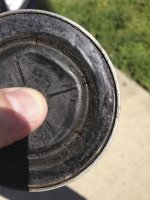Scott
I have a '66 TR4A which came with the Smiths PCV valve. Motor was rebuilt in 2000. Everything worked great until about 2008 when I started getting crankcase pressurization and oil leaking from nearly every seal. I did tones of tests and checks (concerned I was getting excessive blow by from worn rings).
Dry compression test was a perfect 180psi/ 175psi/ 180psi/ 175psi. Manifold vacuum pulled perfect 20" at idle and 22" at 2,000 RPM. Eventually, I traced it all back to a failed original PCV. I tried everything including cleaning and rebuilding the original, purchasing quality used ones from eBay, purchased new ones from one of the big three. Nothing worked. Plus, I identified 5 different models which were all slightly different (part no. stamped on lid).
FVP 2001/02 Original installed on my car 1964-65
FVP 2003/02 1966-68
FVP 2003/08 2[SUP]nd[/SUP] model ordered from eBay
FVP 2003/10 Moss Motors. Listed in catalog for TR4A
FVP 2003/11 for TR6?
I pretty much concluded the original PCV was a poorly designed stop-gap measure by Triumph to meet US emissions laws. I don't think the design was optimized and performed marginally, at best.
I would love nothing better than to update to a modern day PCV system creating 8-10" Hg vacuum in the crankcase but, in the meantime I plugged the manifold connection for the PCV and running a 1/2" rubber hose off the valve cover. The hose runs over the carbs and down near the chassis into the free air below the car. I cut a 90 degree angle on the end so the passing air creates a venturi effect and pulls air from the crankcase. Overall, the hose is about 3' long.
It appears to vent the crankcase as well as anything and no more oil leaks. Not to mention, the car idles much better w/o the PCV installed (since the PCV is essentially a controlled vacuum leak into the intake manifold, it makes it hard to get the idle perfect).
Here are two excellent articles on crankcase ventilation and PCV valves:
https://mgaguru.com/mgtech/engine/cv102.htm
https://mgaguru.com/mgtech/engine/cv103.htm
Regards
Bob

 Hi Guest!
Hi Guest!

 smilie in place of the real @
smilie in place of the real @
 Pretty Please - add it to our Events forum(s) and add to the calendar! >>
Pretty Please - add it to our Events forum(s) and add to the calendar! >> 
 When I started it and ran it to do the block test, the pressure was back down to ~70-80 cold. That's more like it. I had also cleaned out the pressure adjusting apparatus, but decided to just put it back in as it was and didn't make any adjustments. Glad I did.
When I started it and ran it to do the block test, the pressure was back down to ~70-80 cold. That's more like it. I had also cleaned out the pressure adjusting apparatus, but decided to just put it back in as it was and didn't make any adjustments. Glad I did.